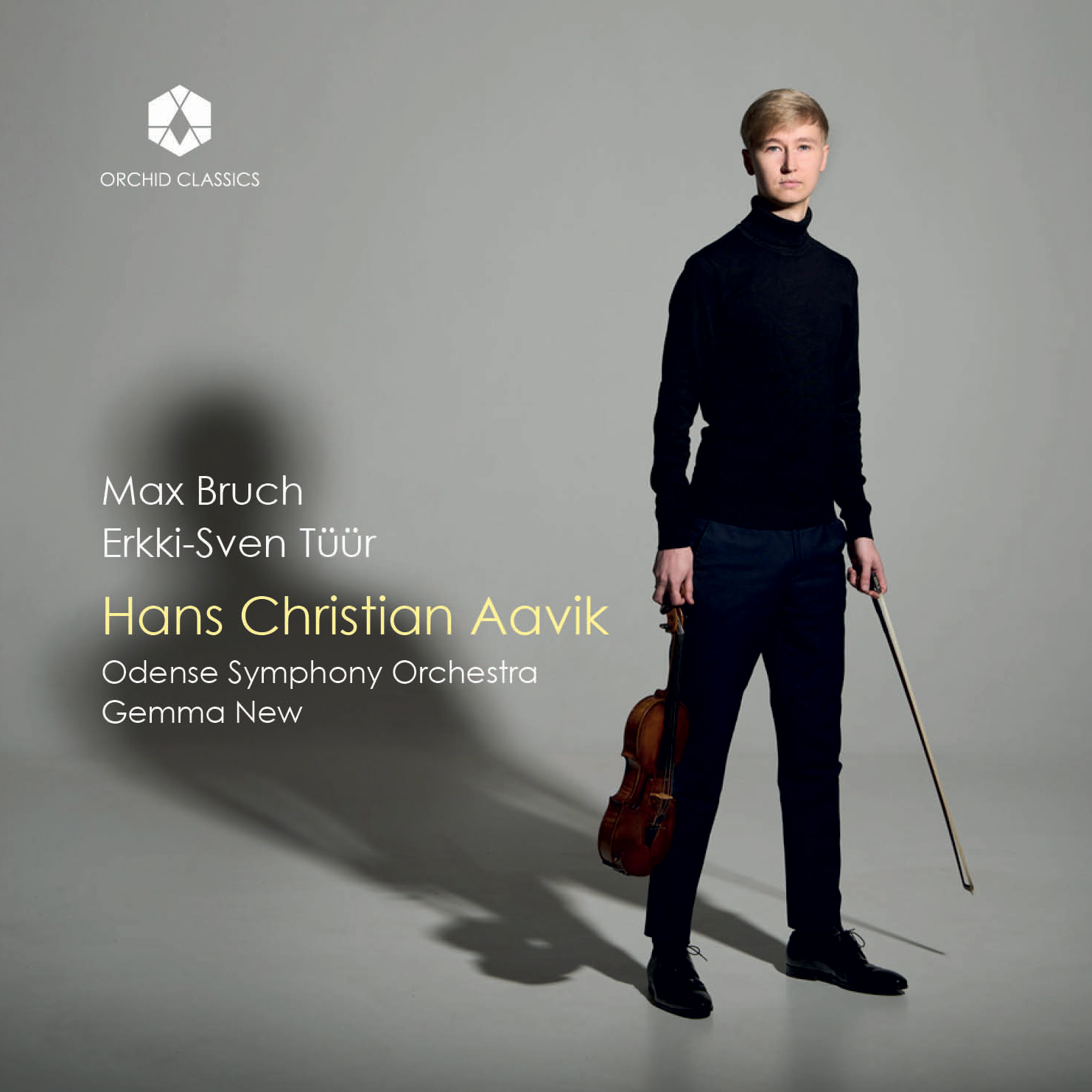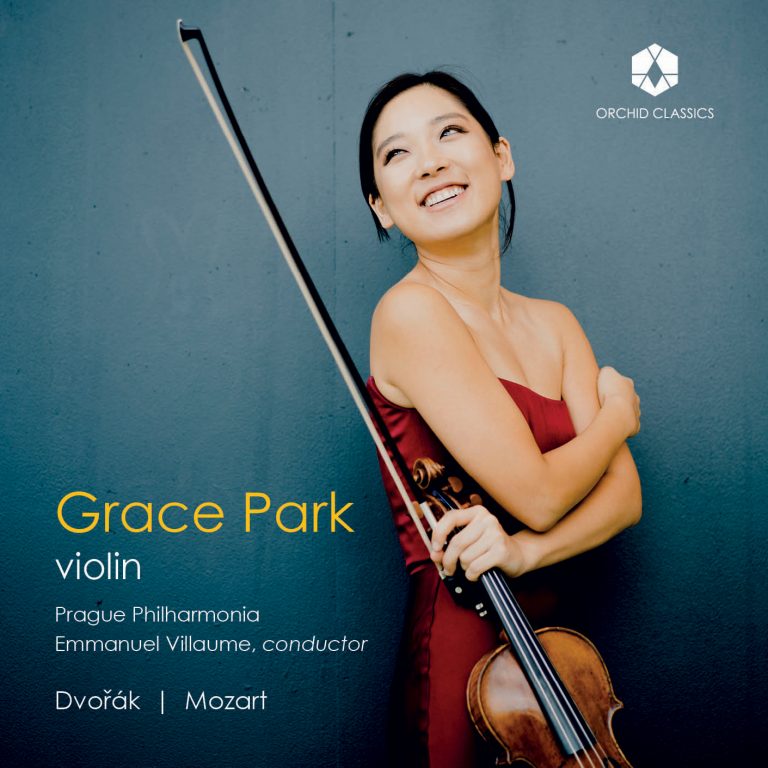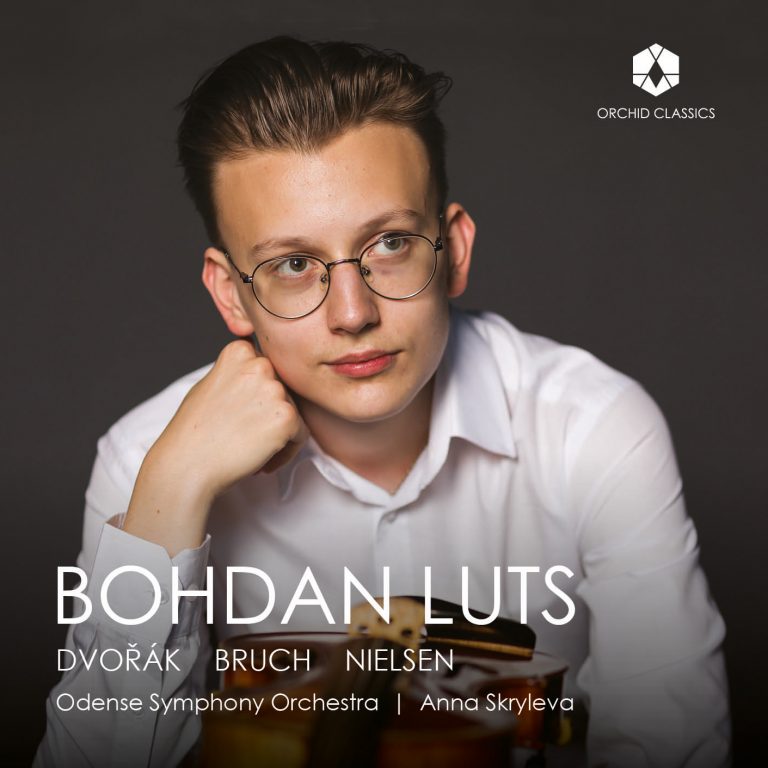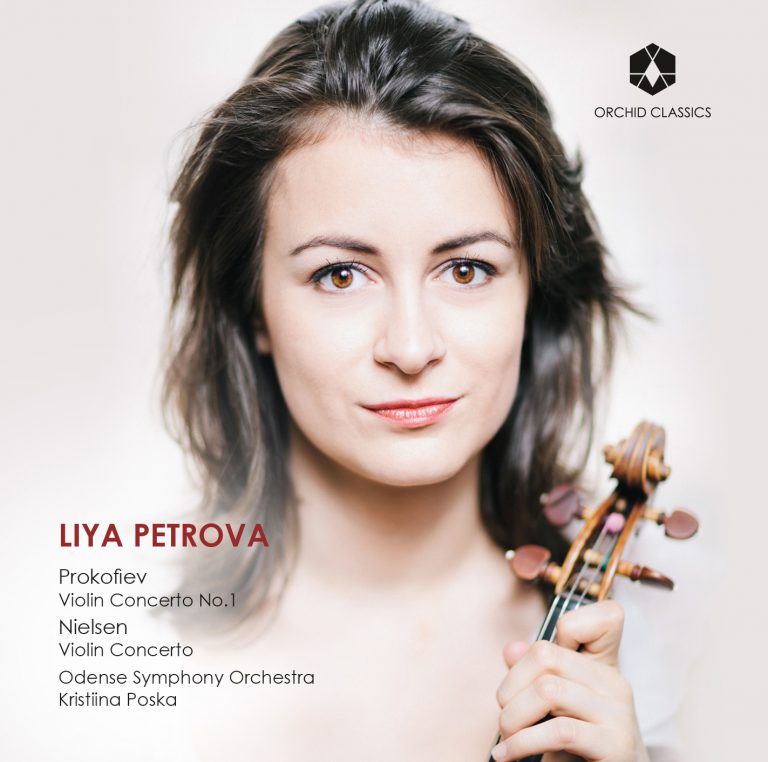Artist Led, Creatively Driven

Hans Christian Aavik, violin
Odense Symphony Orchestra
Gemma New, conductor
Release Date: May 2nd 2025
ORC100380
Max Bruch (1838-1920)
Violin Concerto No.1 in G minor, Op.26
1. I Vorspiel. Allegro moderato
2. II Adagio
3. III Finale. Allegro energico
Erkki-Sven Tüür (b.1959)
4. Violin Concerto No.2, Angel’s Share
Hans Christian Aavik, violin
Odense Symphony Orchestra
Gemma New, conductor
The earliest known appearance of the phrase ‘one-hit wonder’ was in a New York newspaper in 1914. Remarkably, the German Romantic composer Max Bruch was still alive at this time – and although it seems unlikely that he was familiar with the term, it is tempting to apply it to Bruch himself, courtesy of the work that opens his disc. Bruch came in later years to curse the astonishing success and popularity of his First Violin Concerto, completed when he was just 28 years old: none of his considerable later output was to come anywhere near its fame, and he remains principally known to music-lovers today because of this very same piece.
Bruch began his Concerto in the summer of 1864. Buoyed up by critical acclaim of several large-scale choral and orchestral works, he decided to tackle a new genre. It was not easy going: he wrote to a friend in November 1865 that he did not ‘feel sure of my feet on this terrain. Do you not think that it is in fact very audacious to write a Violin Concerto?’ Determined to do the best job he could, and already in touch with several noted violin virtuosi of the day, Bruch organised a run-through with a fine local violinist in Koblenz (where he had recently taken up the job of music director) before sending the manuscript to the renowned soloist Joseph Joachim for his advice. Joachim was one of Johannes Brahms’s closest friends and would eventually premiere Brahms’s own Violin Concerto in 1879. In the meantime, he had already written two of his own – including the so-called ‘Hungarian Concerto’ (Joachim had been born in Hungary) in 1857.
Joachim wrote Bruch a long, detailed and fulsome reply, pointing to specific phrases and articulations that he considered needed adjusting, and making remarks – and offering solutions – as to the structure and drama of the whole. He was warmly enthusiastic and asked if he might be allowed to learn the solo part once the work was complete so that he could perform it. Bruch was sufficiently grateful that he visited Joachim to thank him in person; but his own remaining doubts also prompted him to send the work to yet another performer, Ferdinand David, who had been the dedicatee Felix Mendelssohn’s Violin Concerto twenty years earlier. Ultimately Bruch juggled Joachim’s suggestions with David’s, but spent the next few decades denying that he had received much help from either, clearly worried that his need to seek further advice might look like creative weakness on his part. The piece was finally premiered on 7 January 1868 by Joseph Joachim to resoundingly positive reviews, and within months Joachim had given further performances at several German cities. Other noteworthy violinists including Leopold Auer, Ferdinand David and Henri Vieuxtemps were also quick to add the piece to their repertoire. Meanwhile, in January 1867, Bruch organised the score’s publication. But here, his youth and inexperience cost him, quite literally: he sold the rights entirely to the publishers August Cranz for just 250 thalers. Given the work’s enduring popularity, it could have made him a fortune over the remainder of his long life if he had known how to bargain more effectively.
Bruch had initially wondered whether his work would be best labelled ‘Fantasie’ rather than ‘Concerto’. Rather than three discrete movements, a ‘Vorspiel’, or ‘Prelude’, leads directly into a second movement without pause. Joachim dissuaded him from giving it this alternative label, and it makes for a distinctive concerto structure. In the Vorspiel, the violin unfurls long unaccompanied phrases between brief orchestral punctuations. A brooding Allegro then begins, in which the soloist introduces a restless first theme in D minor and a sweetly lyrical contrasting idea in Bb major. The dramatic introduction eventually returns, prompting a brief cadenza before the music leads seamlessly into the achingly beautiful, deeply intimate slow movement – a movement which was often performed on its own, such was its popularity with audiences. The music comes to rest here, and the work is then rounded off with a sprightly, sunshiny Allegro energico finale stuffed with double-stopped chords for the soloist. It seems highly likely that the dance-like, Hungarian character of this movement was inspired by Joachim’s crucial role as creative advisor, advocate and interpreter.
Bruch’s concerto is followed here by a work completed over 150 years later. The Estonian composer Erkki-Sven Tüür studied classical music in Tallinn before joining the prog rock group Spe in 1979. He spent five years heading Spe, which was one of the most popular Estonian bands of its time, before leaving to concentrate on composition, and has since written nine symphonies, ten instrumental concertos and a host of other chamber and stage works. He draws on a wide range of musical styles and idioms in his works, from Gregorian chant and post-modernist techniques to serialism and sound-fields.
Tüür’s Second Violin Concerto, completed in 2017, is entitled ‘Angel’s Share’. This term relates to whisky making: when whisky is placed into wooden barrels to age, the wood absorbs certain chemicals from the liquor and imbues it with the barrel’s own woody flavour. A small amount of the whisky also evaporates over the years of its maturation, because of the porous nature of wood – and the vanishing quantity is known as the angel’s share. This celestial sacrifice, it is reasoned, is the price that must be paid to give the finished product its rounded, smooth taste and remove any traces of hard-edged bitterness. Tüür muses that this same process can be applied to human beings: that maturity, over time, can lead to an ‘angel’s share’ being taken from us to deepen our sense of goodness and hope, and save us from resentment and cynicism.
The music is, to this end, full of moments in which time itself seems to be held in suspension. A single tone from the violin, matched with ringing crotales, opens the piece, which pairs a string orchestra with a clutch of percussion instruments (vibraphone and bass drum, tam-tam, crotales and temple blocks). Pitches slide up and down strings; the orchestra throws the same brief ideas across ensemble sections; harmonics whistle past. Passages of emphatic, rhythmic restlessness are stopped in their tracks by sonorous chords from the vibraphone, and the double basses rest for bars at a time on a single pitch as the strings tiptoe in the tiniest intervals above them. In the last five minutes, the music picks up a more sustainable groove, temple blocks and plucked strings driving the music forwards. But even this is ultimately interrupted, the string fading away until a final vibraphone chord is left shimmering in the silence. ‘Angel’s Share’ was premiered in Tallinn on 3 May 2018 by violinist Hugo Ticciati and the Tallinn Chamber Orchestra, conducted by Risto Joost.
© Katy Hamilton
Hans Christian Aavik
Violin
Hans Christian Aavik is the 1st prize winner of the 2022 Carl Nielsen International Violin Competition and recipient of the Usedom Prize. Named “One to Watch” by Gramophone, he is praised for his “probing intellect and curiosity” combined with “an extroverted charisma” (Bachtrack).
Born in Tallinn in 1998, Hans Christian has appeared as a soloist with the Estonian National Symphony Orchestra, Tallinn Chamber Orchestra, and Württemberg Chamber Orchestra Heilbronn, where he is the Young Artist in Focus. He performed Bruch’s Violin Concerto at the Pärnu Music Festival with Paavo Järvi and joins the Estonian Festival Orchestra in 2025 for Arvo Pärt’s 90th birthday celebrations, performing Tabula Rasa alongside Midori in Vienna (Musikverein), Zurich (Tonhalle), Hamburg (Elbphilharmonie), and at New York’s Carnegie Hall.
A dedicated chamber musician, he performs the complete Enescu violin sonatas at the 2025 George Enescu Festival. His 2021 debut album AETERNUS features works by Bach, Schubert, and Pärt, and he has recorded for Deutsche Grammophon’s Musical Moments series. In 2024, he performed Mozart’s complete works for violin and orchestra. His artistry has been shaped by mentors including Cristian Măcelaru, Kirill Gerstein, Augustin Hadelich, Steven Isserlis, Sophia Rahman, and Sir András Schiff.
Hans Christian plays a Giovanni Paolo Maggini violin (ca. 1610) and a Victor Fétique bow (ca. 1930), generously loaned by the Estonian Foundation of Musical Instruments and the Sapožnin family.
Gemma New
Conductor
Gemma New (ONZM) is Artistic Advisor and Principal Conductor of the New Zealand Symphony Orchestra. She is the recipient of the prestigious 2021 Sir Georg Solti Conducting Award and was appointed an Officer of the New Zealand Order of Merit in 2024. New previously served as Music Director of the Hamilton Philharmonic Orchestra, Principal Guest Conductor of the Dallas Symphony Orchestra, Resident Conductor of the St. Louis Symphony Orchestra and Associate Conductor of the New Jersey Symphony. A former Dudamel Conducting Fellow with the Los Angeles Philharmonic and Conducting Fellow at Tanglewood, New was awarded Solti Foundation U.S. Career Assistance Awards in 2017, 2019 and 2020, before receiving the 2021 Sir Georg Solti Conducting Award.
Odense Symphony Orchestra
The Odense Symphony Orchestra is one of Denmark’s five regional orchestras. The orchestra was founded in 1946, but its roots go as far back as around 1800. From being a theatre orchestra that also played symphonic music, the orchestra today appears as a modern symphony orchestra with a high level of activity and in a constant state of development. The orchestra’s repertoire has a wide range and covers everything from film concerts, chamber music, family concerts to the great symphonic works and opera, such as Richard Wagner’s Der Ring des Nibelungen.
Odense Symphony Orchestra had 22 musicians at its founding but has grown to 73 permanent musicians over the years, from Denmark and all over the world. The orchestra performs around 100 concerts a year. The majority of the concerts take place in the Carl Nielsen-hall in Odense’s Concert house, near H.C. Andersen’s Birthplace – but the orchestra tours throughout Denmark and the rest of the world.
Odense Symphony Orchestra is the owner and host of Carl Nielsen International Competition, and the orchestra and its musicians play an important role in the competition as jury members, repertoire consultants and contact persons to many international artists. The first of the Carl Nielsen International Competitions was held in Odense in 1980. After nearly four decades, the violin, clarinet and flute competitions have established themselves as some of the most demanding and rewarding in the world, by highlighting Carl Nielsen’s musical masterpieces, and offering each winner the chance to launch a significant international career.
For more information on Carl Nielsen International Competition please visit www.carlnielseninternationalcompetition.com.









